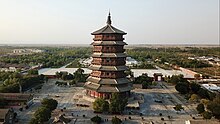Pagoda of Fogong Temple
| Pagoda of Fogong Temple | |
|---|---|
 Front view of the Sakyamuni Pagoda of Fogong Temple | |
| Religion | |
| Affiliation | Buddhism |
| Location | |
| Location | Ying County, Shuozhou, Shanxi, China |
| Country | PRC |
| Geographic coordinates | 39°33′55″N 113°10′55″E / 39.56528°N 113.18194°E |
| Architecture | |
| Type | Chinese |
| Completed | 1056-1195 |
The
The pagoda stands on a 4 m (13 ft) tall stone platform, has a 10 m (33 ft) tall steeple, and reaches a total height of 67.31 m (220.83 ft) tall; it is the oldest existent fully wooden pagoda still standing in China.[4][5] Although it is the oldest fully wooden pagoda in China, the oldest existent densely-eaved pagoda is the 6th century Songyue Pagoda (made of bricks) and many much older stone pagodas exists in the entire North China Plain (e.g. the Zushi Pagoda of the Foguang Temple and the Four Gates Pagoda of Jinan); the oldest existent wooden buildings in China are the Buddhist temple halls found in Wutai County on the westside of the Mount Wutai, which date back to the mid Tang dynasty (618–907).[6]
History



The Pagoda of Fogong Temple was built 85 km (53 mi) south of the Liao dynasty capital at Datong.[5] The Complete Classics Collection of Ancient China encyclopedia published in 1725—written during the reigns of Kangxi and Yongzheng in the Qing—states that a different pagoda built between the years 936–943 stood previously at the site before the present one of 1056 was built.[5] The same statement appears in the Shanxi tongzhi (Record of Shanxi Province) and the Yingzhou xuzhi (Record of Ying Prefecture, Continued).[5] The Yingzhou zhi (Record of Ying Prefecture)—edited by Tian Hui during the reign of the Wanli Emperor (r. 1572–1620) of the Ming dynasty—states that the pagoda was funded and erected in 1056 by a Buddhist monk named Tian.[5][7] In compiling a record for Ying County, Tian Hui of the late Ming dynasty researched the history of the pagoda and recorded the history of its repairs in his Zhongxiu Fogongsi ta zhi.[5] The placard on the third story of the pagoda listed that periodic repairs were conducted in the years 1195 and 1471.[5] While piecing together the history of the pagoda, Tian Hui never came across any information to suggest that the pagoda had a predecessor built from 936 to 943, as other texts suggest.[5]
In confirming the date of 1056 and not the years 936–943, Zhang Yuhuan writes in his Zhongguo gudai jianzhu jishu shi (1985) that the Wenwu Laboratory determined various wooden components from the second to fifth floors of the pagoda to be 930 to 980 years old.
The pagoda was placed at the center of the temple grounds,[10] which used to be called Baogong Temple until its name was changed to Fogong in 1315 during the Yuan dynasty.[11] Although the size of the temple grounds were described as being gigantic during the Jurchen-led Jin dynasty (1115–1234), the temple began to decline during the Ming dynasty.[11]
The Yingzhou zhi records that there was a total of seven earthquakes between the years 1056 and 1103, yet the tower stood firm.
Features

The pagoda features fifty-four different kinds of
Preservation
The Pagoda of Fogong Temple and its surroundings are protected by the
The present
In 2013, the pagoda was placed on China's tentative list for
See also
Notes
- ^ Steinhardt (1997), 20.
- ^ Steinhardt (1997), 103.
- ^ Steinhardt (1994), 8.
- ^ Chinadaily.com.cn (2003).Sakyamuni Pagoda at Fogong Temple Archived 2007-08-24 at the Wayback Machine. Ministry of Culture. Retrieved on 2008-01-25.
- ^ a b c d e f g h i j k l m Steinhardt (1994), 12.
- ^ Steinhardt (2004), 128–154.
- ^ Kuhn (2000), 332.
- ^ Steinhardt (1994), 12, footnote 31.
- ^ a b Steinhardt (1994), 14.
- ^ Steinhardt (1994), 12, 13.
- ^ a b c d e f g h i j k l Steinhardt (1994), 13.
- ^ a b Ma Liang, 2010, 41-42
- ^ Needham, Volume 4, 131.
- ^ "China seeks world heritage status for world's oldest wooden pagoda". news.xinhuanet.com. Archived from the original on 2011-05-17.
- ^ "Application of Sakyamuni Pagoda for UNESCO cultural relics to be finished by July". news.xinhuanet.com. Archived from the original on 30 December 2013. Retrieved 9 August 2022.
- ^ "Wooden Structures of Liao Dynasty—Wooden Pagoda of Yingxian County,Main Hall of Fengguo Monastery of Yixian County". 2014-04-22.
References
- Kuhn, Dieter. "'Liao Architecture': Qidan Innovations and Han-Chinese Traditions?," T'oung Pao, Second Series, Vol. 86, Fasc. 4/5 (2000): 325–362.
- Ma Liang, 2010. The Mysterious Pagoda, Cultural Education Press, ISBN 978-962-8182-42-8, in Chinese (神奇的寶塔/馬良,文化教育出版社).
- Needham, Joseph (1986). Science and Civilization in China: Volume 4, Physics and Physical Technology, Part 3, Civil Engineering and Nautics. Taipei: Caves Books, Ltd.
- Steinhardt, Nancy Shatzman. "Liao: An Architectural Tradition in the Making," Artibus Asiae (Volume 54, Number 1/2, 1994): 5–39.
- Steinhardt, Nancy Shatzman (1997). Liao Architecture. Honolulu: University of Hawaii Press.
- Steinhardt, Nancy Shatzman. "The Tang Architectural Icon and the Politics of Chinese Architectural History," The Art Bulletin (Volume 86, Number 2, 2004): 228–254.
